Impact of Mycorrhization on Phosphorus Utilization Efficiency of Acacia gummifera and Retama monosperma under Salt Stress
Abstract
1. Introduction
2. Materials and Methods
2.1. Biological Materials
2.1.1. Seeds
2.1.2. Mycorrhizal Inoculum
2.2. Experimental Soil and Design
2.3. Salt Stress Treatment
2.4. Mycorrhizal Treatment
2.5. Measurements
2.5.1. Levels of Mycorrhizal Root Colonization Frequencies and Intensities
2.5.2. Shoot and Root Biomass Dry Matter (DM)
2.5.3. Elemental Analyses
2.6. Statistical Analysis
3. Results
3.1. Chemical Properties of the Used Soils
3.2. Variance Analysis
3.3. Mycorrhizal Root Colonization Frequencies and Intensities
3.4. Shoot and Root Dry Matter (DM)
3.5. Tissue-P Concentration and PUE
3.6. Nitrogen Uptake in the Shoots and the Roots
4. Discussion
5. Conclusions
Author Contributions
Funding
Data Availability Statement
Acknowledgments
Conflicts of Interest
References
- Fakhech, A.; Manaut, N.; Ouahmane, L.; Hafidi, M. Contributions of Indigenous Arbuscular Mycorrhizal Fungi to Growth of Retama Monosperma and Acacia Gummifera under Water Stress (Case Study: Essaouira Sand Dunes Forest). J. Sustain. For. 2019, 38, 686–696. [Google Scholar] [CrossRef]
- Kearl, J.; McNary, C.; Lowman, J.S.; Mei, C.; Aanderud, Z.T.; Smith, S.T.; West, J.; Colton, E.; Hamson, M.; Nielsen, B.L. Salt-Tolerant Halophyte Rhizosphere Bacteria Stimulate Growth of Alfalfa in Salty Soil. Front. Microbiol. 2019, 10, 1849. [Google Scholar] [CrossRef] [PubMed]
- Evelin, H.; Kapoor, R.; Giri, B. Arbuscular Mycorrhizal Fungi in Alleviation of Salt Stress: A Review. Ann. Bot. 2009, 104, 1263–1280. [Google Scholar] [CrossRef] [PubMed]
- Yang, Y.; Guo, Y. Unraveling Salt Stress Signaling in Plants: Salt Stress Signaling. J. Integr. Plant Biol. 2018, 60, 796–804. [Google Scholar] [CrossRef]
- Arzani, A.; Ashraf, M. Smart Engineering of Genetic Resources for Enhanced Salinity Tolerance in Crop Plants. Crit. Rev. Plant Sci. 2016, 35, 146–189. [Google Scholar] [CrossRef]
- Yu, Z.; Duan, X.; Luo, L.; Dai, S.; Ding, Z.; Xia, G. How Plant Hormones Mediate Salt Stress Responses. Trends Plant Sci. 2020, 11, P1117–P1130. [Google Scholar] [CrossRef]
- Orozco-Mosqueda, M.d.C.; Duan, J.; DiBernardo, M.; Zetter, E.; Campos-García, J.; Glick, B.R.; Santoyo, G. The Production of ACC Deaminase and Trehalose by the Plant Growth Promoting Bacterium Pseudomonas Sp. UW4 Synergistically Protect Tomato Plants Against Salt Stress. Front. Microbiol. 2019, 10, 1392. [Google Scholar] [CrossRef]
- Evelin, H.; Devi, T.S.; Gupta, S.; Kapoor, R. Mitigation of Salinity Stress in Plants by Arbuscular Mycorrhizal Symbiosis: Current Understanding and New Challenges. Front. Plant Sci. 2019, 10, 470. [Google Scholar] [CrossRef] [PubMed]
- Ruiz-Lozano, J.M.; Azcon, R.; Gomez, M. Alleviation of Salt Stress by Arbuscular-Mycorrhizal Glomus Species in Lactuca Sativa Plants. Physiol. Plant. 1996, 98, 767–772. [Google Scholar] [CrossRef]
- James, D.; Borphukan, B.; Fartyal, D.; Ram, B.; Singh, J.; Manna, M.; Sheri, V.; Panditi, V.; Yadav, R.; Achary, V.M.M.; et al. Concurrent Overexpression of OsGS1;1 and OsGS2 Genes in Transgenic Rice (Oryza Sativa L.): Impact on Tolerance to Abiotic Stresses. Front. Plant Sci. 2018, 9, 786. [Google Scholar] [CrossRef]
- Isayenkov, S.V.; Maathuis, F.J.M. Plant Salinity Stress: Many Unanswered Questions Remain. Front. Plant Sci. 2019, 10, 80. [Google Scholar] [CrossRef]
- Kumar, J.; Singh, S.; Singh, M.; Srivastava, P.K.; Mishra, R.K.; Singh, V.P.; Prasad, S.M. Transcriptional Regulation of Salinity Stress in Plants: A Short Review. Plant Gene 2017, 11, 160–169. [Google Scholar] [CrossRef]
- Saddhe, A.A.; Malvankar, M.R.; Karle, S.B.; Kumar, K. Reactive Nitrogen Species: Paradigms of Cellular Signaling and Regulation of Salt Stress in Plants. Environ. Exp. Bot. 2019, 161, 86–97. [Google Scholar] [CrossRef]
- Augé, R.M.; Toler, H.D.; Saxton, A.M. Arbuscular Mycorrhizal Symbiosis Alters Stomatal Conductance of Host Plants More under Drought than under Amply Watered Conditions: A Meta-Analysis. Mycorrhiza 2015, 25, 13–24. [Google Scholar] [CrossRef]
- Smith, S.; Read, D. Mycorrhizal Symbiosis, 3rd ed.; Academic Press: London, UK, 2008. [Google Scholar]
- Bothe, H. Arbuscular Mycorrhiza and Salt Tolerance of Plants. Symbiosis 2012, 58, 7–16. [Google Scholar] [CrossRef]
- Porcel, R.; Aroca, R.; Azcon, R.; Ruiz-Lozano, J.M. Regulation of Cation Transporter Genes by the Arbuscular Mycorrhizal Symbiosis in Rice Plants Subjected to Salinity Suggests Improved Salt Tolerance Due to Reduced Na+ Root-to-Shoot Distribution. Mycorrhiza 2016, 26, 673–684. [Google Scholar] [CrossRef] [PubMed]
- Wang, F.; Sun, Y.; Shi, Z. Arbuscular Mycorrhiza Enhances Biomass Production and Salt Tolerance of Sweet Sorghum. Microorganisms 2019, 7, 289. [Google Scholar] [CrossRef]
- Ren, C.-G.; Kong, C.-C.; Xie, Z.-H. Role of Abscisic Acid in Strigolactone-Induced Salt Stress Tolerance in Arbuscular Mycorrhizal Sesbania Cannabina Seedlings. BMC Plant Biol. 2018, 18, 74. [Google Scholar] [CrossRef] [PubMed]
- Chen, Y.L.; Liu, R.J.; Bi, Y.L.; Feng, G. Use of Mycorrhizal Fungi for Forest Plantations and Minesite Rehabilitation. In Mycorrhizal Fungi: Use in Sustainable Agriculture and Land Restoration; Solaiman, Z.M., Abbott, L.K., Varma, A., Eds.; Soil Biology; Springer: Berlin/Heidelberg, Germany, 2014; pp. 325–355. ISBN 978-3-662-45370-4. [Google Scholar]
- Bender, S.F.; Wagg, C.; van der Heijden, M.G.A. An Underground Revolution: Biodiversity and Soil Ecological Engineering for Agricultural Sustainability. Trends Ecol. Evol. 2016, 31, 440–452. [Google Scholar] [CrossRef]
- Fakhech, A.; Ouahmane, L.; Hafidi, M. Analysis of Symbiotic Microbial Status of Atlantic Sand Dunes Forest and Its Effects on Acacia Gummifera and Retama Monosperma (Fabaceae) to Be Used in Reforestation. J. For. Res. 2020, 31, 1309–1317. [Google Scholar] [CrossRef]
- Lamin, H.; Alami, S.; Bouhnik, O.; ElFaik, S.; Abdelmoumen, H.; Bedmar, E.J.; Missbah-El Idrissi, M. Nodulation of Retama Monosperma by Ensifer Aridi in an Abandonned Lead Mine Soils in Eastern Morocco. Front. Microbiol. 2019, 10, 1456. [Google Scholar] [CrossRef]
- Tak, N.; Gehlot, H.S. Diversity of Nitrogen-Fixing Symbiotic Rhizobia with Special Reference to Indian Thar Desert. In Microbial Diversity in Ecosystem Sustainability and Biotechnological Applications: Volume 2. Soil & Agroecosystems; Satyanarayana, T., Das, S.K., Johri, B.N., Eds.; Springer: Singapore, 2019; pp. 31–55. ISBN 9789811384875. [Google Scholar]
- Ahmed, M.M.E.; Iqbal Khan, M.A.; Kabir, S.; Fukuta, Y.; Obara, M. Genetic Variations of Root Development Traits under Different Concentrations and Forms of Nitrogen in Bangladeshi Rice (Oryza Sativa L.) Accessions. Soil Sci. Plant Nutr. 2020, 31–40. [Google Scholar] [CrossRef]
- Baamrane, M.A.A.; Shehzad, W.; Ouhammou, A.; Abbad, A.; Naimi, M.; Coissac, E.; Taberlet, P.; Znari, M. Assessment of the Food Habits of the Moroccan Dorcas Gazelle in M’Sabih Talaa, West Central Morocco, Using the TrnL Approach. PLoS ONE 2012, 7, e35643. [Google Scholar] [CrossRef]
- Tang, H.; Niu, L.; Wei, J.; Chen, X.; Chen, Y. Phosphorus Limitation Improved Salt Tolerance in Maize through Tissue Mass Density Increase, Osmolytes Accumulation, and Na+ Uptake Inhibition. Front. Plant Sci. 2019, 10. [Google Scholar] [CrossRef]
- Meddich, A.; Jaiti, F.; Bourzik, W.; Asli, A.E.; Hafidi, M. Use of Mycorrhizal Fungi as a Strategy for Improving the Drought Tolerance in Date Palm (Phoenix Dactylifera). Sci. Hortic. 2015, 192, 468–474. [Google Scholar] [CrossRef]
- Phillips, J.M.; Hayman, D.S. Improved Procedures for Clearing Roots and Staining Parasitic and Vesicular-Arbuscular Mycorrhizal Fungi for Rapid Assessment of Infection. Trans. Br. Mycol. Soc. 1970, 55, 158–161. [Google Scholar] [CrossRef]
- Brundrett, M.C.; Piché, Y.; Peterson, R.L. A New Method for Observing the Morphology of Vesicular–Arbuscular Mycorrhizae. Can. J. Bot. 1984, 62, 2128–2134. [Google Scholar] [CrossRef]
- Trouvelot, A.; Kough, J.L.; Gianinazzi-Pearson, V. Measurement of VA mycorrhizal rate of a root system estimation methods research with functional significance. In Physiological and Genetical Aspects of Mycorrhizae; INRA: Paris, France, 1986; pp. 217–221. [Google Scholar]
- Toubali, S.; Tahiri, A.; Anli, M.; Symanczik, S.; Boutasknit, A.; Ait-El-Mokhtar, M.; Ben-Laouane, R.; Oufdou, K.; Ait-Rahou, Y.; Ben-Ahmed, H.; et al. Physiological and Biochemical Behaviors of Date Palm Vitroplants Treated with Microbial Consortia and Compost in Response to Salt Stress. Appl. Sci. 2020, 10, 8665. [Google Scholar] [CrossRef]
- Novozamsky, I.; Houba, V.J.G.; van Eck, R.; van Vark, W. A Novel Digestion Technique for Multi-element Plant Analysis. Commun. Soil Sci. Plant. Anal. 1983, 14, 239–248. [Google Scholar] [CrossRef]
- Murphy, J.; Riley, J.P. A Modified Single Solution Method for the Determination of Phosphate in Natural Waters. Anal. Chim. Acta 1962, 27, 31–36. [Google Scholar] [CrossRef]
- Rose, T.J.; Wissuwa, M. Rethinking Internal Phosphorus Utilization Efficiency. Adv. Agron. 2012, 116, 183–217. [Google Scholar]
- Baon, J.B.; Smith, S.E.; Alston, A.M. Mycorrhizal Responses of Barley Cultivars Differing in P Efficiency. Plant. Soil 1993, 157, 97–105. [Google Scholar] [CrossRef]
- The R Foundation for Statistical Computing; R Version 4.0; The R Foundation: Vienna, Austria, 2020.
- Ennaji, W.; Barakat, A.; Karaoui, I.; Baghdadi, M.E.; Arioua, A. Remote Sensing Approach to Assess Salt-Affected Soils in the North-East Part of Tadla Plain, Morocco. Geol. Ecol. Landsc. 2018, 2, 22–28. [Google Scholar] [CrossRef]
- Delvian; Rambey, R. Effect of Salinity on Spore Germination, Hyphal Length and Root Colonization of the Arbuscular Mycorrhizal Fungi. IOP Conf. Ser. Earth Environ. Sci. 2019, 260, 012124. [Google Scholar] [CrossRef]
- Yang, R.; Qin, Z.; Wang, J.; Xu, S.; Zhao, W.; Zhang, X.; Huang, Z. Salinity Changes Root Occupancy by Arbuscular Mycorrhizal Fungal Species. Pedobiologia 2020, 81–82, 150665. [Google Scholar] [CrossRef]
- Beltrano, J.; Ruscitti, M.; Arango, M.C.; Ronco, M. Effects of Arbuscular Mycorrhiza Inoculation on Plant Growth, Biological and Physiological Parameters and Mineral Nutrition in Pepper Grown under Different Salinity and P Levels. J. Soil Sci. Plant Nutr. 2013, 13, 123–141. [Google Scholar] [CrossRef]
- Porras-Soriano, A.; Soriano-Martín, M.L.; Porras-Piedra, A.; Azcón, R. Arbuscular Mycorrhizal Fungi Increased Growth, Nutrient Uptake and Tolerance to Salinity in Olive Trees under Nursery Conditions. J. Plant Physiol. 2009, 166, 1350–1359. [Google Scholar] [CrossRef]
- Teh, C.-Y.; Shaharuddin, N.A.; Ho, C.-L.; Mahmood, M. Exogenous Proline Significantly Affects the Plant Growth and Nitrogen Assimilation Enzymes Activities in Rice (Oryza Sativa) under Salt Stress. Acta Physiol. Plant. 2016, 38, 151. [Google Scholar] [CrossRef]
- Zhu, X.; Song, F.; Liu, S.; Liu, F. Role of Arbuscular Mycorrhiza in Alleviating Salinity Stress in Wheat (Triticum Aestivum L.) Grown Under Ambient and Elevated CO2. J. Agron. Crop. Sci. 2016, 202, 486–496. [Google Scholar] [CrossRef]
- Cavagnaro, T.R.; Bender, S.F.; Asghari, H.R.; van der Heijden, M.G.A. The Role of Arbuscular Mycorrhizas in Reducing Soil Nutrient Loss. Trends Plant Sci. 2015, 20, 283–290. [Google Scholar] [CrossRef]
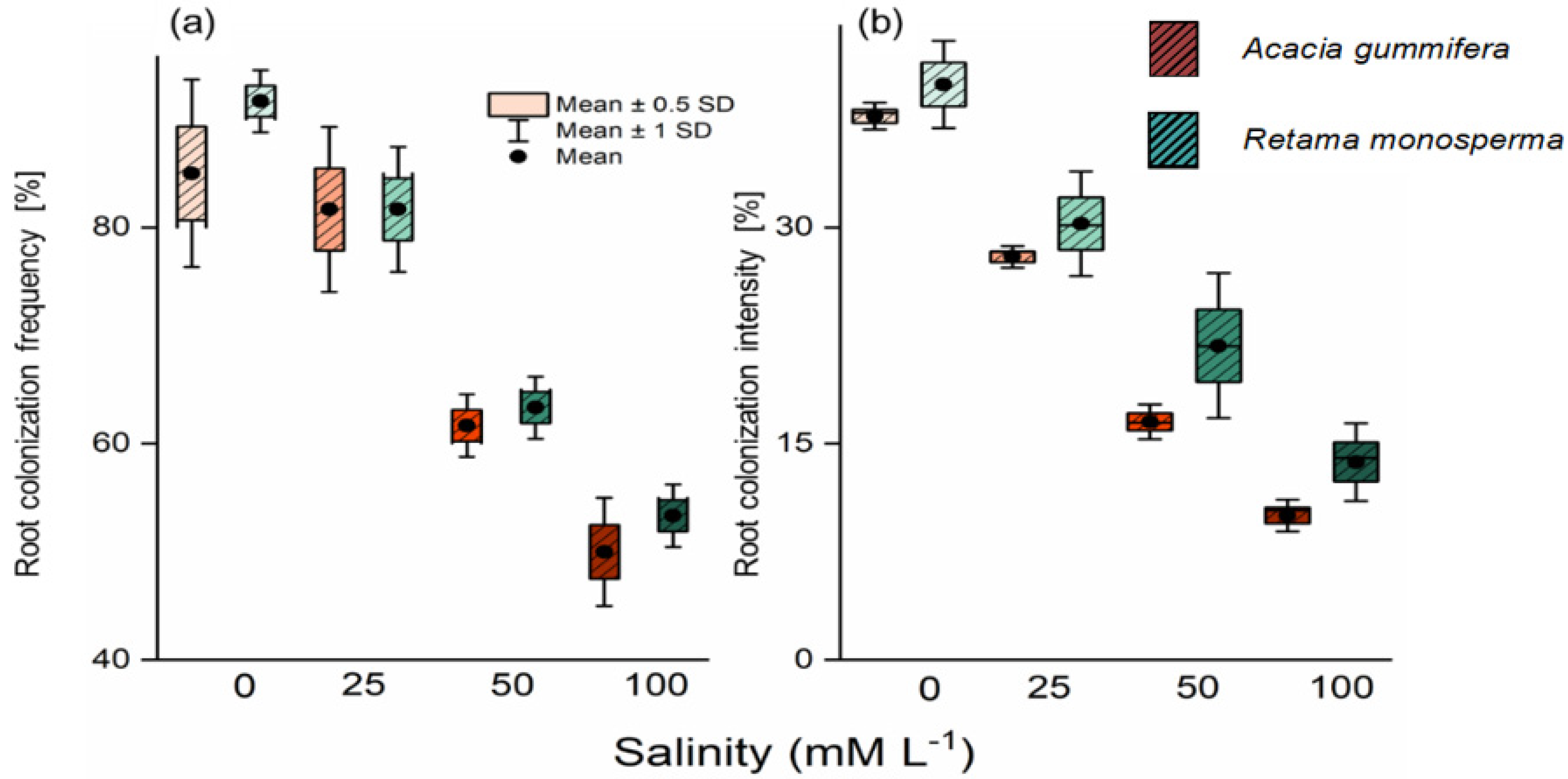
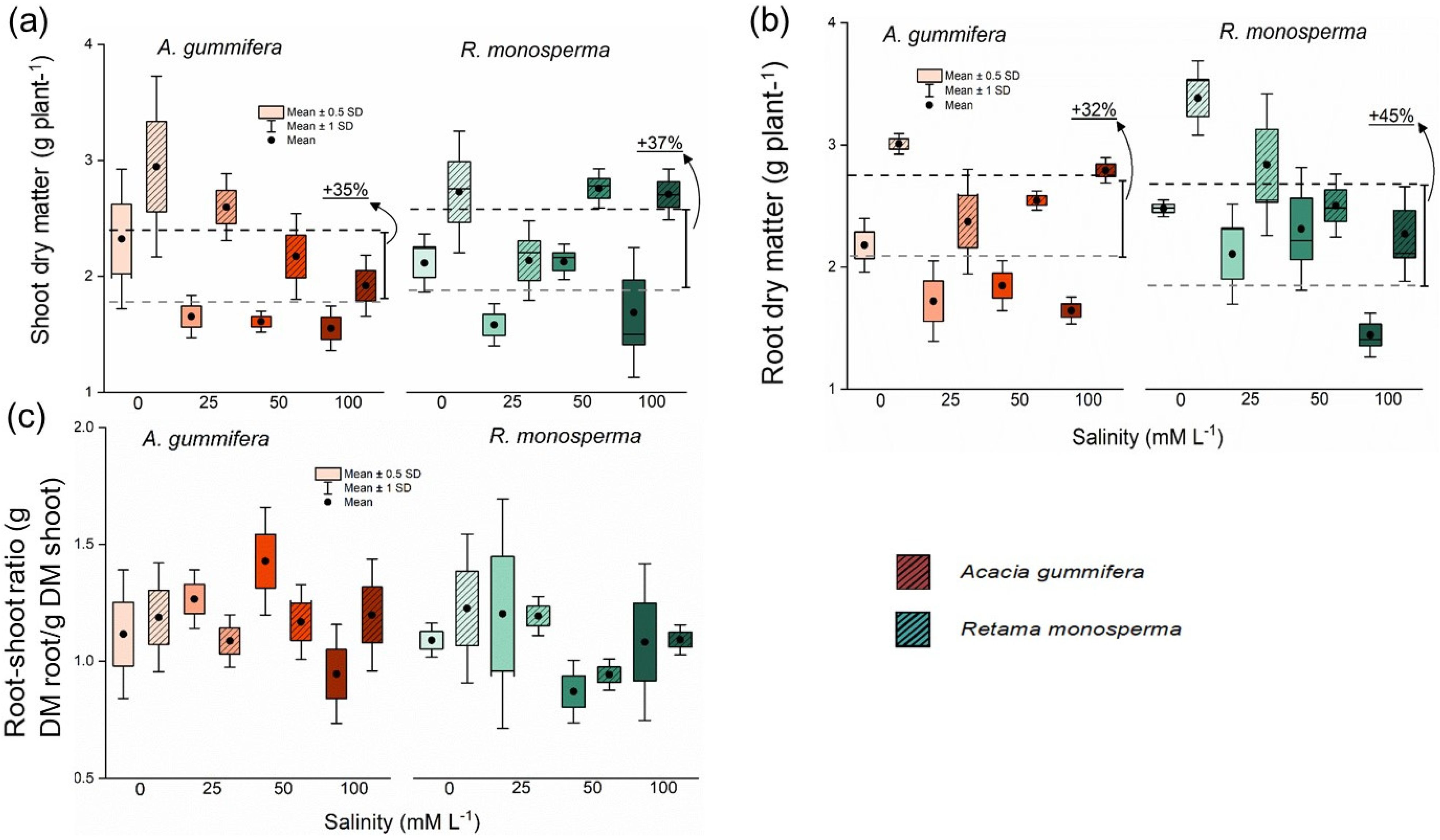
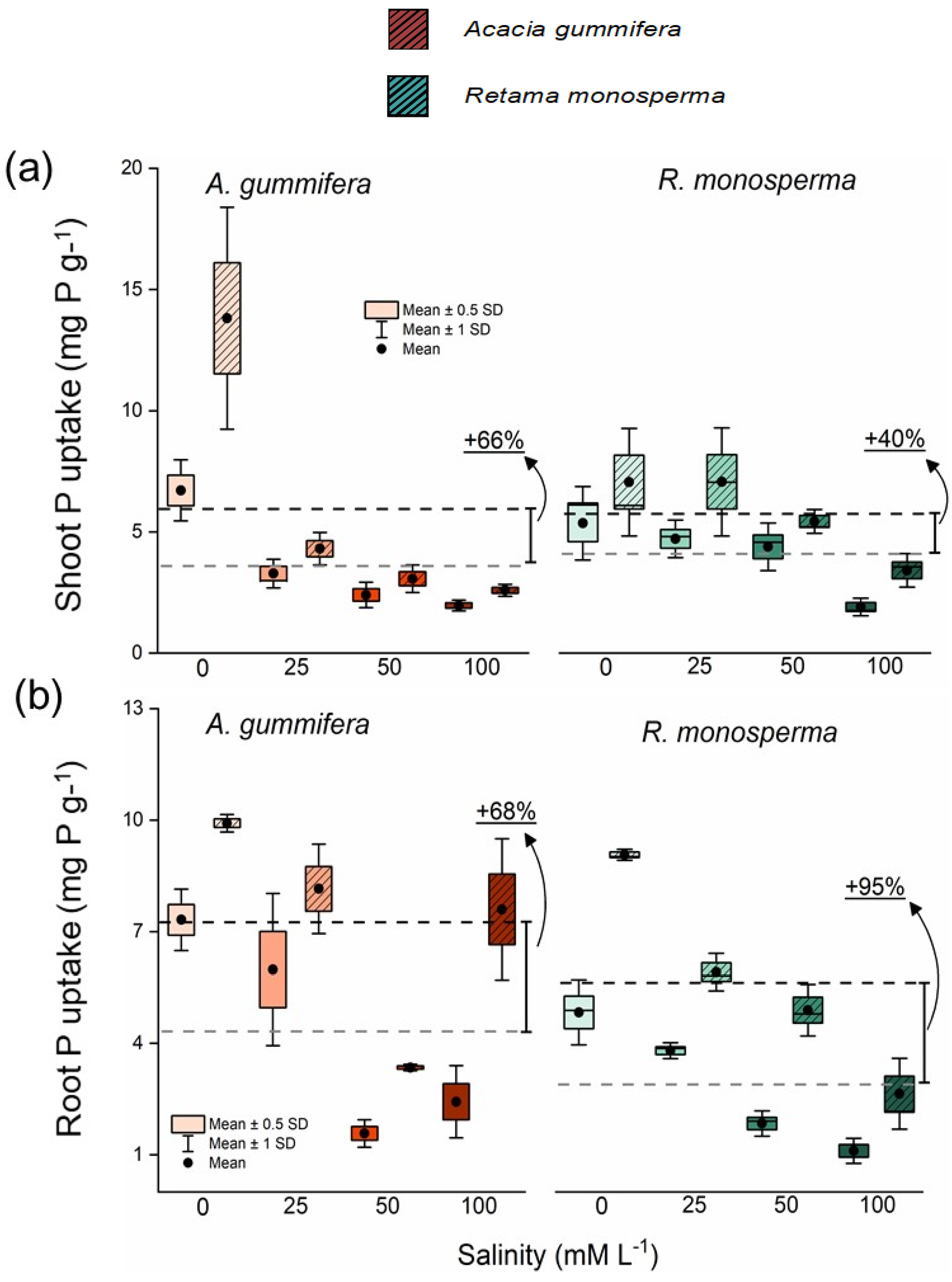
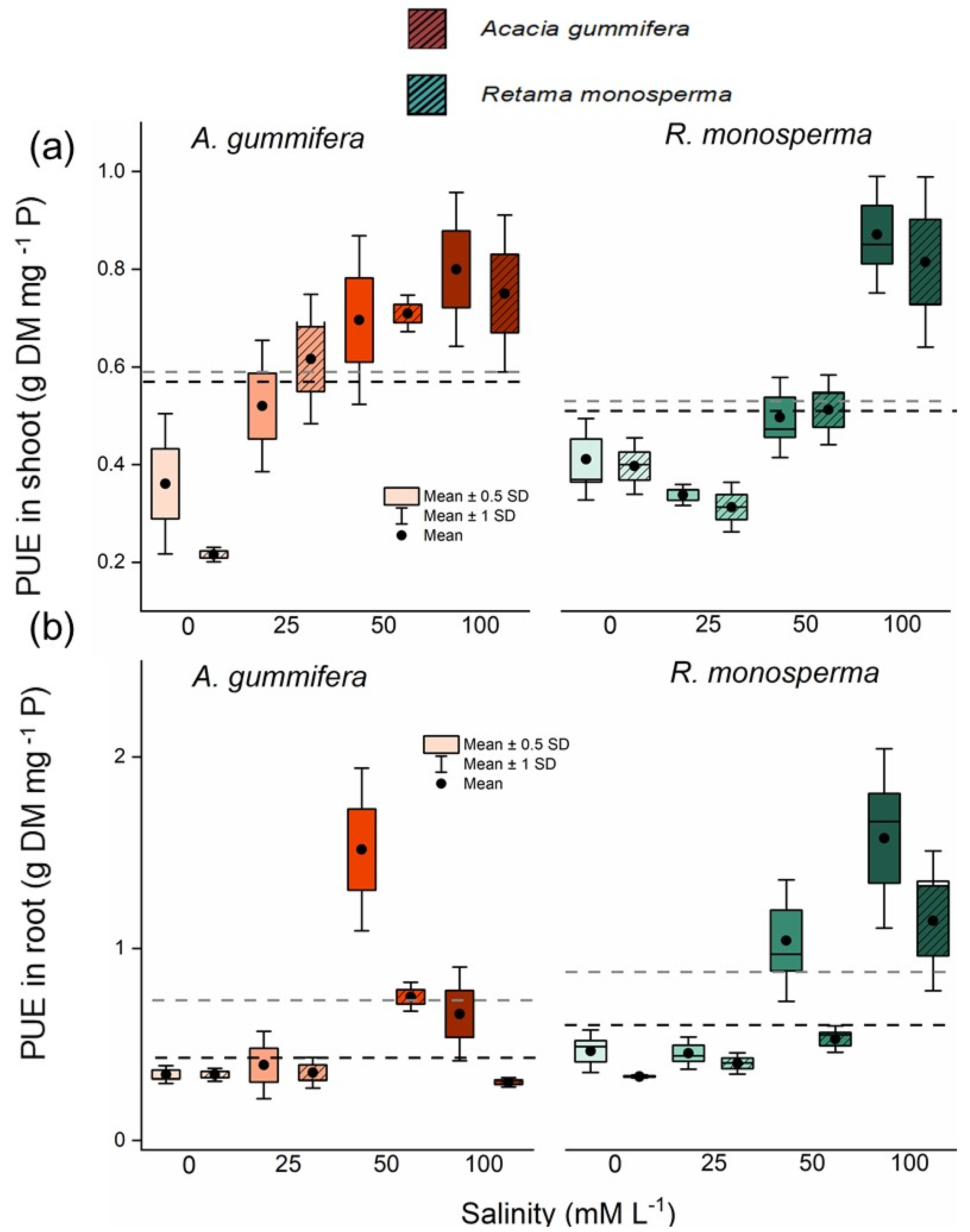
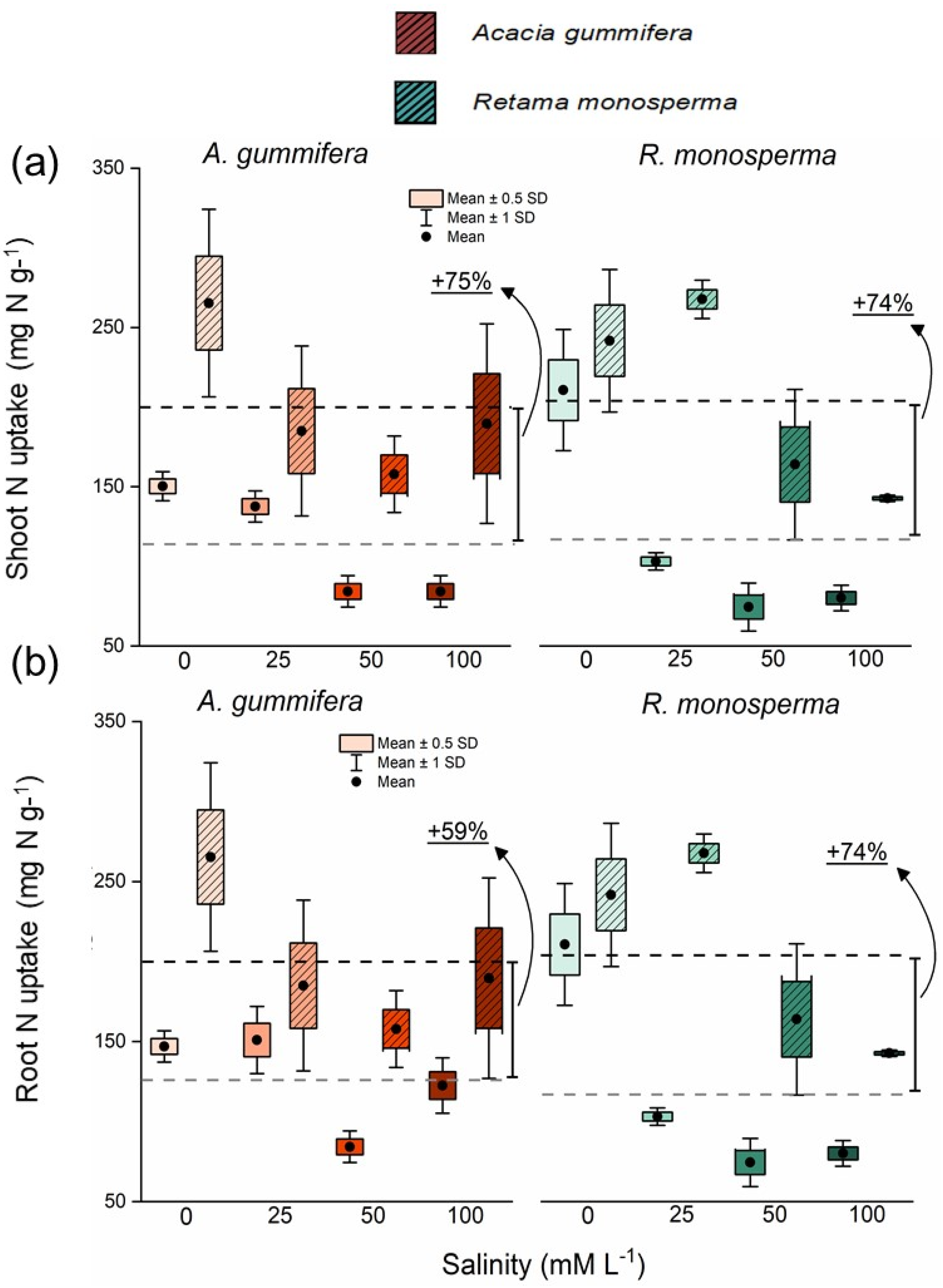
| Source of Variation | F Value | |||||||||||
|---|---|---|---|---|---|---|---|---|---|---|---|---|
| DF | MCF | MCI | SDM | RDM | R-S | SPU | RPU | PUEshoot | PUEroot | SNU | RNU | |
| Legume (L) species | 1 | 1.4 (ns) | 10.7 (**) | 1.5 (ns) | 2.9 (ns) | 6.5 (*) | 0.7 (ns) | 32.5 (***) | 3.8 (*) | 6.4 (*) | 12.9 (**) | 0.05 (ns) |
| Salinity (S) treatment | 3 | 46.6 (***) | 109.7 (***) | 5.7 (**) | 11.7 (***) | 0.5 (ns) | 30.1 (***) | 71.8 (***) | 37.6 (***) | 25.7 (***) | 7.9 (***) | 20.3 (***) |
| Mycorrhizal (M) inoculation | 1 | 463.0 (***) | 582.0 (***) | 37.8 (***) | 70.4 (***) | 0.01 (ns) | 20.0 (***) | 111.7 (***) | 0.4 (ns) | 20.6 (***) | 67.3 (***) | 68.7 (***) |
| L × S | 3 | 0.5 (ns) | 0.7 (ns) | 4.1 (*) | 3.9 (*) | 2.3 (ns) | 10.6 (***) | 10.4 (***) | 7.6 (***) | 16.6 (***) | 8.5 (***) | 2.4 (ns) |
| L × M | 1 | 1.4 (ns) | 10.7 (**) | 0.1 (ns) | 0.8 (ns) | 0.3 (ns) | 0.6 (ns) | 0.2 (ns) | 0.01 (ns) | 0.01 (ns) | 1.9 (ns) | 0.5 (ns) |
| S × M | 3 | 43.6 (***) | 109.7 (***) | 0.1 (ns) | 1.8 (ns) | 1.1 (ns) | 3.3 (*) | 1.5 (ns) | 0.7 (ns) | 5.1 (**) | 6.5 (***) | 0.6 (ns) |
| L × S × M | 3 | 0.5 (ns) | 0.5 (ns) | 0.9 (ns) | 0.7 (ns) | 1.1 (ns) | 3.0 (*) | 5.0 (**) | 0.6 (ns) | 0.4 (ns) | 2.3 (ns) | 5.4 (**) |
| Coefficient of variation (%) | 10.2 | 9.0 | 17.2 | 12.8 | 17.3 | 32.0 | 18.5 | 20.7 | 33.0 | 15.0 | 20.7 | |
Publisher’s Note: MDPI stays neutral with regard to jurisdictional claims in published maps and institutional affiliations. |
© 2021 by the authors. Licensee MDPI, Basel, Switzerland. This article is an open access article distributed under the terms and conditions of the Creative Commons Attribution (CC BY) license (https://creativecommons.org/licenses/by/4.0/).
Share and Cite
Fakhech, A.; Jemo, M.; Manaut, N.; Ouahmane, L.; Hafidi, M. Impact of Mycorrhization on Phosphorus Utilization Efficiency of Acacia gummifera and Retama monosperma under Salt Stress. Forests 2021, 12, 611. https://doi.org/10.3390/f12050611
Fakhech A, Jemo M, Manaut N, Ouahmane L, Hafidi M. Impact of Mycorrhization on Phosphorus Utilization Efficiency of Acacia gummifera and Retama monosperma under Salt Stress. Forests. 2021; 12(5):611. https://doi.org/10.3390/f12050611
Chicago/Turabian StyleFakhech, Abdessamad, Martin Jemo, Najat Manaut, Lahcen Ouahmane, and Mohamed Hafidi. 2021. "Impact of Mycorrhization on Phosphorus Utilization Efficiency of Acacia gummifera and Retama monosperma under Salt Stress" Forests 12, no. 5: 611. https://doi.org/10.3390/f12050611
APA StyleFakhech, A., Jemo, M., Manaut, N., Ouahmane, L., & Hafidi, M. (2021). Impact of Mycorrhization on Phosphorus Utilization Efficiency of Acacia gummifera and Retama monosperma under Salt Stress. Forests, 12(5), 611. https://doi.org/10.3390/f12050611





